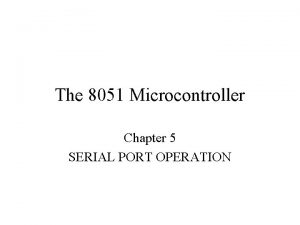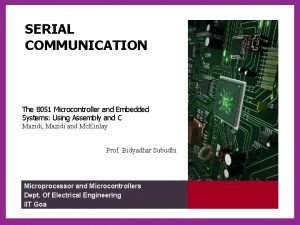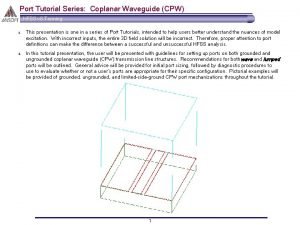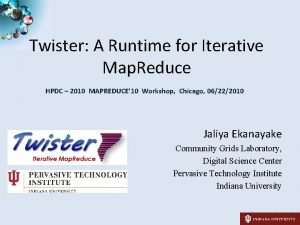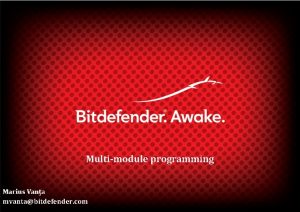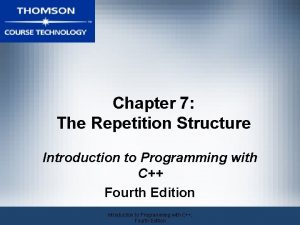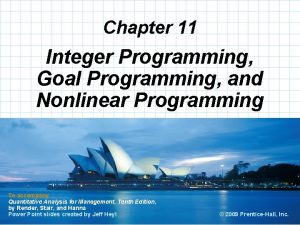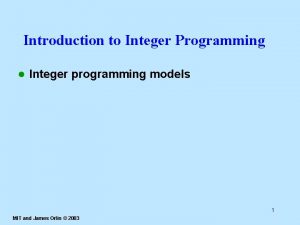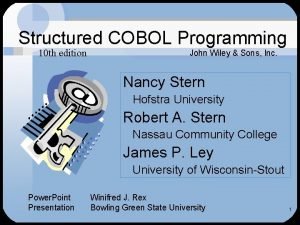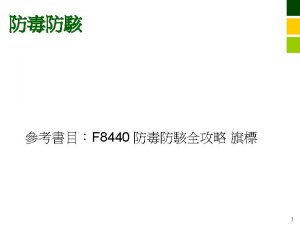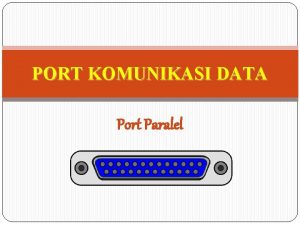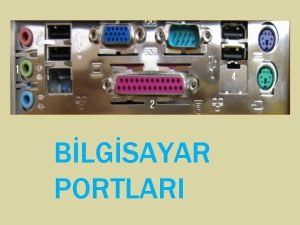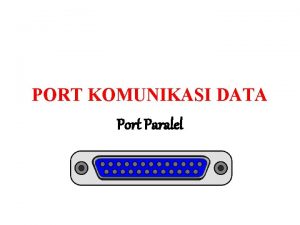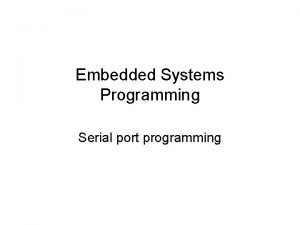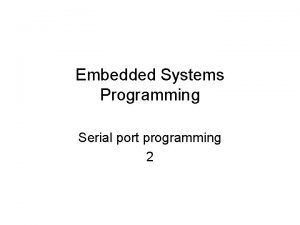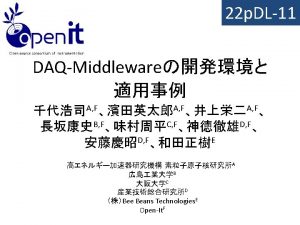IO Port Programming Port 1pins 1 8 Port






























- Slides: 30

I/O Port Programming Port 1(pins 1 -8) • Port 1 is denoted by P 1. – P 1. 0 ~ P 1. 7 • We use P 1 as examples to show the operations on ports. – P 1 as an output port (i. e. , write CPU data to the external pin) – P 1 as an input port (i. e. , read pin data into CPU bus) 4/10/2007 ESD, USIT, GGSIPU 1

A Pin of Port 1 Read latch TB 2 Vcc Load(L 1) Internal CPU bus D Write to latch Clk P 1. X pin Q P 1. X Q M 1 TB 1 Read pin 4/10/2007 ESD, USIT, GGSIPU 8051 IC 2

Hardware Structure of I/O Pin • Each pin of I/O ports – Internal CPU bus:communicate with CPU – A D latch store the value of this pin • D latch is controlled by “Write to latch” – Write to latch= 1:write data into the D latch – 2 Tri-state buffer: • TB 1: controlled by “Read pin” – Read pin= 1:really read the data present at the pin • TB 2: controlled by “Read latch” – Read latch= 1:read value from internal latch – A transistor M 1 gate • Gate=0: open • Gate=1: close 4/10/2007 ESD, USIT, GGSIPU 3

Tri-state Buffer Output Input Tri-state control (active high) L L H 4/10/2007 H H H ESD, USIT, GGSIPU Low Highimpedance (open-circuit) 4

Writing “ 1” to Output Pin P 1. X Read latch Vcc TB 2 Load(L 1) 2. output pin is Vcc 1. write a 1 to the pin Internal CPU bus D Write to latch Clk 1 Q P 1. X pin P 1. X Q 0 M 1 output 1 TB 1 Read pin 4/10/2007 ESD, USIT, GGSIPU 8051 IC 5

Writing “ 0” to Output Pin P 1. X Read latch Vcc TB 2 Load(L 1) 2. output pin is ground 1. write a 0 to the pin Internal CPU bus D Write to latch Clk 0 Q P 1. X pin P 1. X Q 1 M 1 output 0 TB 1 Read pin 4/10/2007 ESD, USIT, GGSIPU 8051 IC 6

Port 1 as Output(Write to a Port) • Send data to Port 1: BACK: MOV A, #55 H MOV P 1, A ACALL DELAY CPL A SJMP BACK – Let P 1 toggle. – You can write to P 1 directly. 4/10/2007 ESD, USIT, GGSIPU 7

Reading Input v. s. Port Latch • When reading ports, there are two possibilities: – Read the status of the input pin. (from external pin value) • MOV A, PX • JNB P 2. 1, TARGET ; jump if P 2. 1 is not set • JB P 2. 1, TARGET ; jump if P 2. 1 is set • Figures C-11, C-12 – Read the internal latch of the output port. • ANL P 1, A ; P 1 ← P 1 AND A • ORL P 1, A ; P 1 ← P 1 OR A • INC P 1 ; increase P 1 • Figure C-17 • Table C-6 Read-Modify-Write Instruction (or Table 8 -5) • See Section 8. 3 4/10/2007 ESD, USIT, GGSIPU 8

Reading “High” at Input Pin Read latch 1. TB 2 write a 1 to the pin MOV P 1, #0 FFH Internal CPU bus 2. MOV A, P 1 Vcc external pin=High Load(L 1) D 1 Q 1 P 1. X pin P 1. X Write to latch Clk 0 Q M 1 TB 1 Read pin 3. Read pin=1 Read latch=0 Write to latch=1 4/10/2007 8051 IC ESD, USIT, GGSIPU 9

Reading “Low” at Input Pin Read latch 1. Vcc write a 1 to the pin 2. MOV A, P 1 TB 2 Load(L 1) external pin=Low MOV P 1, #0 FFH Internal CPU bus D 1 Q 0 P 1. X pin P 1. X Write to latch Clk Q 0 M 1 TB 1 Read pin 3. Read pin=1 Read latch=0 Write to latch=1 4/10/2007 8051 IC ESD, USIT, GGSIPU 10

Port 1 as Input(Read from Port) • In order to make P 1 an input, the port must be programmed by writing 1 to all the bit. BACK: MOV MOV SJMP A, #0 FFH P 1, A A, P 1 P 2, A BACK ; A=1111 B ; make P 1 an input port ; get data from P 0 ; send data to P 2 – To be an input port, P 0, P 1, P 2 and P 3 have similar methods. 4/10/2007 ESD, USIT, GGSIPU 11

Instructions For Reading an Input Port • Following are instructions for reading external pins of ports: Mnemonics Examples Description MOV A, PX MOV A, P 2 Bring into A the data at P 2 pins JNB PX. Y, . . JNB P 2. 1, TARGET Jump if pin P 2. 1 is low JB PX. Y, . . JB P 1. 3, TARGET Jump if pin P 1. 3 is high MOV C, PX. Y MOV C, P 2. 4 Copy status of pin P 2. 4 to CY 4/10/2007 ESD, USIT, GGSIPU 12

Reading Latch • Exclusive-or the Port 1: MOV P 1, #55 H ; P 1=0101 ORL P 1, #0 F 0 H ; P 1=11110101 1. The read latch activates TB 2 and bring the data from the Q latch into CPU. • Read P 1. 0=0 2. CPU performs an operation. • This data is ORed with bit 1 of register A. Get 1. 3. The latch is modified. • D latch of P 1. 0 has value 1. 4. The result is written to the external pin. • External pin (pin 1: P 1. 0) has value 1. 4/10/2007 ESD, USIT, GGSIPU 13

Reading the Latch 1. Read pin=0 Read latch=1 Write to latch=0 (Assume P 1. X=0 initially) Read latch Vcc TB 2 Load(L 1) 2. CPU compute P 1. X OR 1 0 Internal CPU bus D 1 Write to latch 3. write result to latch Read pin=0 Read latch=0 Write to latch=1 0 Q P 1. X Clk 1 4. P 1. X=1 P 1. X pin 0 M 1 Q TB 1 Read pin 8051 IC 4/10/2007 ESD, USIT, GGSIPU 14

Read-modify-write Feature • Read-modify-write Instructions – Table C-6 • This features combines 3 actions in a single instruction: 1. CPU reads the latch of the port 2. CPU perform the operation 3. Modifying the latch 4. Writing to the pin – Note that 8 pins of P 1 work independently. 4/10/2007 ESD, USIT, GGSIPU 15

Port 1 as Input(Read from latch) • Exclusive-or the Port 1: MOV P 1, #55 H ; P 1=0101 AGAIN: XOR P 1, #0 FFH ; complement ACALL DELAY SJMP AGAIN – Note that the XOR of 55 H and FFH gives AAH. – XOR of AAH and FFH gives 55 H. – The instruction read the data in the latch (not from the pin). – The instruction result will put into the latch and the pin. 4/10/2007 ESD, USIT, GGSIPU 16

Read-Modify-Write Instructions Mnemonics 4/10/2007 Example ANL P 1, A ORL P 1, A XRL P 1, A JBC PX. Y, TARGET JBC P 1. 1, TARGET CPL P 1. 2 INC DEC P 1 DJNZ PX, TARGET DJNZ P 1, TARGET MOV PX. Y, C MOV P 1. 2, C CLR PX. Y CLR P 1. 3 SETB PX. Y SETB P 1. 4 P 1 ESD, USIT, GGSIPU 17

You are able to answer this Questions: • How to write the data to a pin? • How to read the data from the pin? – Read the value present at the external pin. • Why we need to set the pin first? – Read the value come from the latch(not from the external pin). • Why the instruction is called read-modify write? 4/10/2007 ESD, USIT, GGSIPU 18

Other Pins • P 1, P 2, and P 3 have internal pull-up resisters. – P 1, P 2, and P 3 are not open drain. • P 0 has no internal pull-up resistors and does not connects to Vcc inside the 8051. – P 0 is open drain. – Compare the figures of P 1. X and P 0. X. • However, for a programmer, it is the same to program P 0, P 1, P 2 and P 3. • All the ports upon RESET are configured as output. 4/10/2007 ESD, USIT, GGSIPU 19

A Pin of Port 0 Read latch TB 2 Internal CPU bus D Write to latch Clk P 0. X pin Q P 1. X Q M 1 TB 1 P 1. x Read pin 4/10/2007 ESD, USIT, GGSIPU 8051 IC 20

Port 0(pins 32 -39) • P 0 is an open drain. – Open drain is a term used for MOS chips in the same way that open collector is used for TTL chips. • When P 0 is used for simple data I/O we must connect it to external pull-up resistors. – Each pin of P 0 must be connected externally to a 10 K ohm pull-up resistor. – With external pull-up resistors connected upon reset, port 0 is configured as an output port. 4/10/2007 ESD, USIT, GGSIPU 21

Port 0 with Pull-Up Resistors Vcc 10 K 4/10/2007 Port 0 P 0. 0 DS 5000 P 0. 1 P 0. 2 8751 P 0. 3 P 0. 4 8951 P 0. 5 P 0. 6 P 0. 7 ESD, USIT, GGSIPU 22

Dual Role of Port 0 • When connecting an 8051/8031 to an external memory, the 8051 uses ports to send addresses and read instructions. – 8031 is capable of accessing 64 K bytes of external memory. – 16 -bit address:P 0 provides both address A 0 -A 7, P 2 provides address A 8 -A 15. – Also, P 0 provides data lines D 0 -D 7. • When P 0 is used for address/data multiplexing, it is connected to the 74 LS 373 to latch the address. – There is no need for external pull-up resistors as shown in Chapter 14. 4/10/2007 ESD, USIT, GGSIPU 23

74 LS 373 PSEN ALE P 0. 0 74 LS 373 G D P 0. 7 OE OC A 0 A 7 D 0 D 7 EA 4/10/2007 P 2. 0 A 8 P 2. 7 A 15 8051 ESD, USIT, GGSIPU ROM 24

Reading ROM (1/2) P 0. 0 2. 74373 latches the address and send to OE ROM OC G 74 LS 373 A 0 P 0. 7 A 7 PSEN ALE 1. Send address to ROM D Address D 0 D 7 EA P 2. 0 A 8 P 2. 7 A 12 8051 4/10/2007 ESD, USIT, GGSIPU ROM 25

Reading ROM (2/2) 2. 74373 latches the PSEN ALE P 0. 0 P 0. 7 address and send to ROM 74 LS 373 G D Address OE OC A 0 A 7 D 0 D 7 EA 4/10/2007 3. ROM send the instruction back P 2. 0 A 8 P 2. 7 A 12 8051 ESD, USIT, GGSIPU ROM 26

ALE Pin • The ALE pin is used for de-multiplexing the address and data by connecting to the G pin of the 74 LS 373 latch. – When ALE=0, P 0 provides data D 0 -D 7. – When ALE=1, P 0 provides address A 0 -A 7. – The reason is to allow P 0 to multiplex address and data. 4/10/2007 ESD, USIT, GGSIPU 27

Port 2(pins 21 -28) • Port 2 does not need any pull-up resistors since it already has pull-up resistors internally. • In an 8031 -based system, P 2 are used to provide address A 8 -A 15. 4/10/2007 ESD, USIT, GGSIPU 28

Port 3(pins 10 -17) • Port 3 does not need any pull-up resistors since it already has pull-up resistors internally. • Although port 3 is configured as an output port upon reset, this is not the way it is most commonly used. • Port 3 has the additional function of providing signals. – Serial communications signal:Rx. D, Tx. D(Chapter 10) – External interrupt:/INT 0, /INT 1(Chapter 11) – Timer/counter:T 0, T 1(Chapter 9) – External memory accesses in 8031 -based system:/WR, /RD(Chapter 14) 4/10/2007 ESD, USIT, GGSIPU 29

Port 3 Alternate Functions 4/10/2007 P 3 Bit Function Pin P 3. 0 P 3. 1 P 3. 2 P 3. 3 P 3. 4 P 3. 5 P 3. 6 P 3. 7 Rx. D Tx. D INT 0 INT 1 T 0 T 1 WR RD 10 11 12 13 14 15 16 17 ESD, USIT, GGSIPU 30
 Perbedaan linear programming dan integer programming
Perbedaan linear programming dan integer programming Programing adalah
Programing adalah Greedy algorithm vs dynamic programming
Greedy algorithm vs dynamic programming What is in system programming
What is in system programming Integer programming vs linear programming
Integer programming vs linear programming Samd21 uart example
Samd21 uart example The 8051 family of microcontrollers has a serial port
The 8051 family of microcontrollers has a serial port Serial communication
Serial communication Read and write signals in 8255 are tri state
Read and write signals in 8255 are tri state Port a + port c upper forms group b ports
Port a + port c upper forms group b ports Lumped port in hfss
Lumped port in hfss Java language
Java language Java programming
Java programming Iconic programming
Iconic programming Twister programming model
Twister programming model Haas macro variables
Haas macro variables Integral data type
Integral data type Hierarchy in a pseudo code
Hierarchy in a pseudo code Mit android programming
Mit android programming Python chapter 5 programming exercises
Python chapter 5 programming exercises Language
Language Modular programming
Modular programming Repetition structure c++
Repetition structure c++ Cs 1101 programming fundamentals
Cs 1101 programming fundamentals Integer programming problem
Integer programming problem Vex programming
Vex programming Arc (programming language)
Arc (programming language) Integer programming mit
Integer programming mit Gui ruby
Gui ruby Et 500 gate motor battery
Et 500 gate motor battery Structured cobol programming
Structured cobol programming






